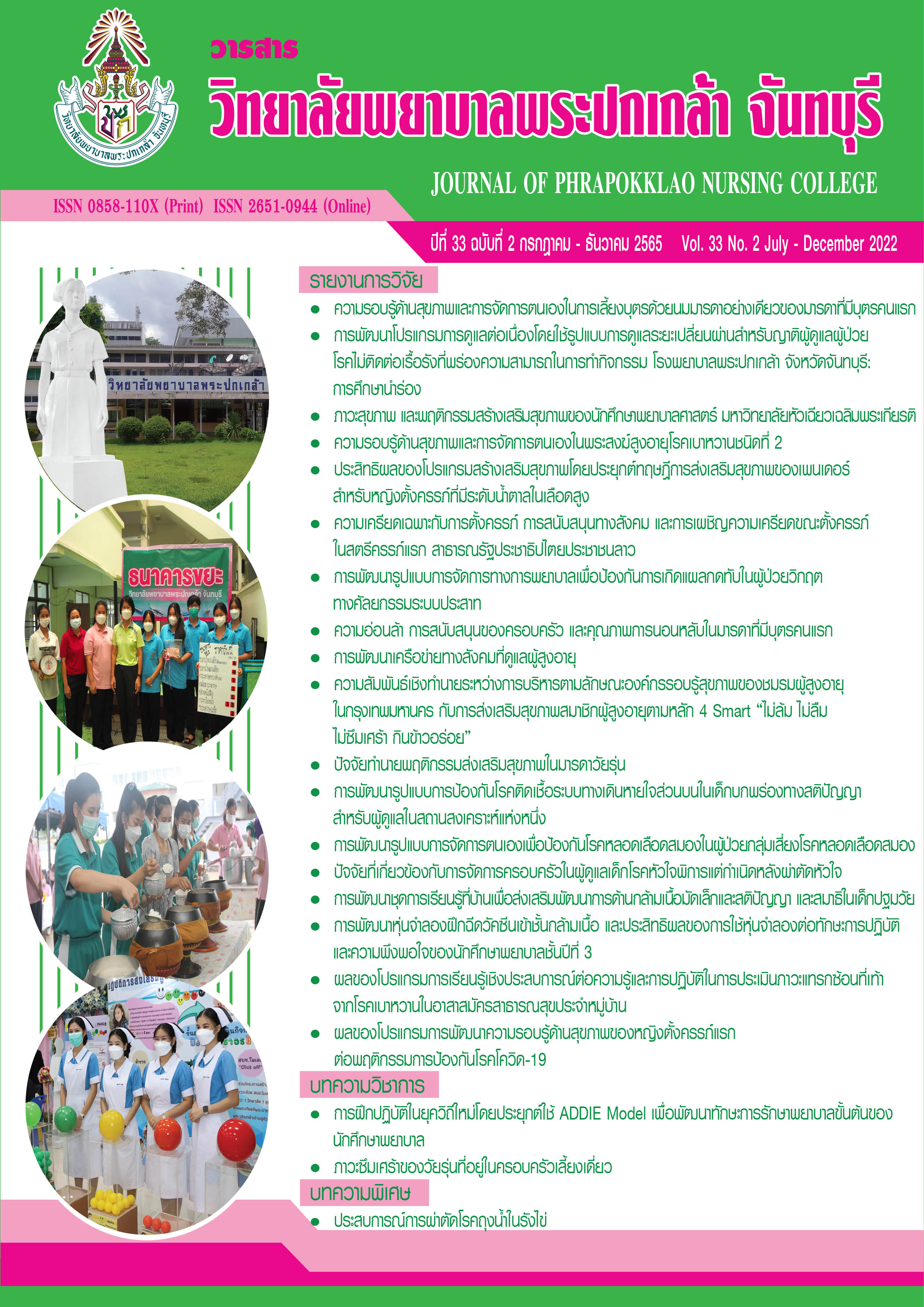Developing a Vaccination Model for Intramuscular Injection and Its Effect upon Performance Skills and Satisfaction of Third-year Nursing Students
Keywords:
Vaccination model, Intramuscular injection, Nursing students, Performance skills, SatisfactionAbstract
This research and development aimed to develop and study the effect of a vaccination model for intramuscular injection. There were two phases including: 1) model development and validation; and 2) model evaluation. Samples consisted of 97 third-year nursing students who were studying at Faculty of Nursing, Thammasat University and were divided into the experimental group (n = 46) and the control group (n = 51). The research instruments included a vaccination model for intramuscular injection, a performance skill evaluation form with reliability of .80, and a vaccination model quality evaluation form with reliability of .92. The implementation and data collection were conducted from January to August 2019. Data were analyzed using mean, standard deviation, and independent t-test.
The research results revealed that 1) a vaccination model for intramuscular injection was developed from silicone. It was designed to imitate the human structure of an entire infant’s body, skin color, texture, and body size. The developed model was found to facilitate vaccination practice; 2) after intervention, the experimental group had statistically significantly higher mean score of performance skill than that of the control group (t = 6.811, p < .001); and 3) the experimental group had the total mean score of satisfaction toward vaccination model quality at a very high level (M = 4.62, SD = .36).
This research suggests that nursing instructors should adopt this vaccination model for intramuscular injection as a media to promote preclinic vaccination practice achievement of students.
References
กองโรคป้องกันด้วยวัคซีน กรมควบคุมโรค. (2561). มาตรฐานการดำเนินงานสร้างเสริมภูมิคุ้มกันโรคประจำปี 2561. สืบค้นจาก http://dvpd.ddc.moph.go.th/storage/content /file%20standard/1528956173-0085
คณะพยาบาลศาสตร์ มหาวิทยาลัยธรรมศาสตร์. (2560). คู่มือการดำเนินงานตามมาตรฐานหลักสูตรพยาบาลศาสตรบัณฑิต. ปทุมธานี: มหาวิทยาลัยธรรมศาสตร์.
ปฐมามาศ โชติบัณ, กิตติพร เนาว์สุวรรณ, ธารินี นนทพุทธ, และจรูญรัตน์ รอดเนียม. (2556). นวัตกรรมชุดหุ่นฝึกทักษะการปฏิบัติการพยาบาล. วารสารมหาวิทยาลัยนราธิวาสราชนครินทร์, 5(3), 1–12.
สุสัณหา ยิ้มแย้ม. (2559). การพัฒนาหุ่นจำลองเพื่อฝึกทักษะทางคลินิกของนักศึกษาสาขาวิทยาศาสตร์สุขภาพ. พยาบาลสาร, 43(2), 142–151.
Albaqawi, M. H., Dayrit, R. D. J., Gonzales, F. M., Algahtani, F., Alboliteeh, M., Albagawi, B., & Alshammari, F. (2020). Perceived benefits of simulation-based training among nursing students of the University of Hail. International Journal of Advanced and Applied Sciences, 7(1), 60–71. doi:10.21833/ijaas.2020.01.006
Aldoobie, N. (2015). ADDIE Model. American International Journal of Contemporary Research, 5(6), 68–72. Retrieved from http://www.aijcrnet.com/journals/Vol_5_No_6_December_2015/10.pdf
Bandura, A. (1997). Self-efficacy: The exercise of control. New York: W.H. Freeman and Company.
Kim, J. H., Park, J. H., & Shin, S. (2016). Effectiveness of simulation-based nursing education depending on fidelity: A meta-analysis. BMC Medical Education, 16(1), 1–8. doi:10.1186/s12909-016-0672-7
La Cerra, C., Dante, A., Caponnetto, V., Franconi, I., Gaxhja, E., Petrucci, C., … Lancia, L. (2019). Effects of high-fidelity simulation based on life-threatening clinical condition scenarios on learning outcomes of undergraduate and postgraduate nursing students: A systematic review and meta-analysis. BMJ Open, 9(2), 1–11. doi:10.1136/bmjopen-2018-025306
Park, S. H., Kim, L. H., Shin, S. J., Lee, D. H., Park, W. J., Cho, H. C., & Kim, H. J. (2011). US Patent No. 2012301858A1: Injection simulation system and method. Washington, DC: U.S. Patent and Trademark Office.
Rios, G. A., & Foster, C. B. (2015). US Patent No. 10235904B2: Injection training tool emitting omnidirectional light. Washington, DC: U.S. Patent and Trademark Office.
World Health Organization. (2019). The global vaccine action plan 2011–2020: Review and lessons learned: Strategic advisory group of experts on immunization. Retrieved from https://apps.who.int/iris/handle/10665/329097
Downloads
Published
How to Cite
Issue
Section
License
Copyright (c) 2022 JOURNAL OF PHRAPOKKLAO NURSING COLLEGE

This work is licensed under a Creative Commons Attribution-NonCommercial-NoDerivatives 4.0 International License.
เนื้อความ ข้อมูล และรายการอ้างอิงที่ผู้เขียนใช้ในการเขียนบทความเพื่อลงตีพิมพ์ในวารสารวิทยาลัยพยาบาลพระปกเกล้า จันทบุรี ถือเป็นความคิดเห็นและความรับผิดชอบของผู้เขียน คณะผู้จัดทำวารสารไม่จำเป็นต้องเห็นพ้องด้วยหรือร่วมรับผิดชอบ
บทความที่ได้รับการลงตีพิมพ์ในวารสารวิทยาลัยพยาบาลพระปกเกล้า จันทบุรี ถือเป็นลิขสิทธิ์ของวารสารวิทยาลัยพยาบาลพระปกเกล้า จันทบุรี หากหน่วยงานหรือบุคคลใดต้องการนำส่วนหนึ่งหรือทั้งหมดของบทความไปเผยแพร่ต่อเพื่อวัตถุประสงค์ใด ๆ จะต้องได้รับอนุญาตจากบรรณาธิการวารสารก่อน



